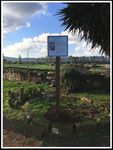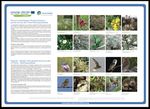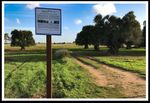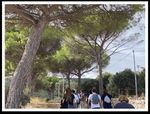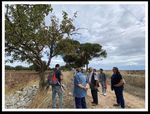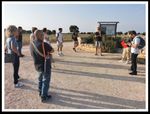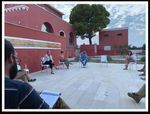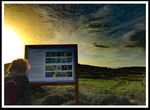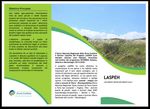LASPEH "Low Adriatic SPEcies and Habitat" D.T1.3.1 Concrete actions for habitat - LP "Natural Regional Park of Coastal Dunes from Torre Canne to ...
←
→
Page content transcription
If your browser does not render page correctly, please read the page content below
LASPEH “Low Adriatic SPEcies and Habitat”
D.T1.3.1 Concrete actions for habitat
LP “Natural Regional Park of Coastal Dunes from Torre Canne to Torre San Leonardo” – Report ver. 1Index
1 Introduction ......................................................................................................................... 3
2 Digital Communication Strategy ........................................................................................... 6
3 Concrete Actions .................................................................................................................. 7
4 Time Schedule .................................................................................................................... 39
2
D.T1.3.1 Concrete Actions1 Introduction
The concrete actions in the following report were selected from the concrete actions plan included
in the Pseudo-steppe Habitat Conservation Plan under the LASPEH project.
In detail, the Park of the Coastal Dunes has planned a series of actions in support of the habitat
"*6220 Pseudo-steppe with grasses and annuals (Thero-Brachypodietea)" to protect it through the
conservation of traditional agricultural practices, such as controlled grazing, linked to the
conservation and protection of this habitat.
This in order to create a virtuous model capable of generating good practices that can be replicated
for other farmers in the area affected by the economic impact resulting from the added value that
these traditional productions can generate in terms of eco-services systems linked to the
conservation of endangered habitats throughout Europe.
Within the Park, the only areas that still preserve the habitat " Pseudo-steppe with grasses and
annuals (Thero-Brachypodietea)" spared from the practice of plowing, fall within farms with farms
that carry out breeding in the wild.
There is a close interconnection between the pasture and the habitat, connection that generated a
balance that ensured the conservation of the habitat.
In view of this, only if pasture is profitable
enough will the habitat be preserved, only if
the milk, meat and cheese obtained from
this traditional farming practice will receive
the right value, then we could guarantee a
high level of biodiversity of fauna and flora.
Otherwise, these areas will always be at risk
of transformation to start intensive
agricultural models of cereals and
horticultural products. It will therefore be
important to ensure that those involved
maintain ecologically and economically
sustainable farming and farming practices.
The overview objectives of the Actions selected in the Conservation Plan are the following:
SHORT-TERM
a. To ensure the protection and conservation of the existing "patches" of Thero-Brachypodietea
(pseudo-steppe)
b. To raise awareness among the local community
c. To avoid abandonment of traditional practices
d. To promote cooperation and local branding for typical products
3
D.T1.3.1 Concrete ActionsMEDIUM-TERM
a. Improving the ecosystem potential of agricultural areas
b. Reducing anthropogenic impacts
c. Regulating grazing activities
d. Consortium of agro-pastoral activities
LONG-TERM
a. Widening the extent of habitat by reducing its fragmentation
b. Incentives for grazing and habitat maintenance
Regarding the LASPEH Project, the concrete actions selected from the Plan are the following:
- Action A2c: To encourage grazing in the wild in order to support the conservation of the habitat
"Pseudo-steppe with grasses and annuals (Thero-Brachypodietea)";
- Action A4c: Local community awareness action on biodiversity issues;
- Action A2d: “Cacio sotto il cielo” (cheese under the sky) promotional campaign;
- Action A4d: Creation of educational panels to be placed close to the habitat.
The actions were selected through a process of stakeholder empowerment, below some photos of
the meetings held on 13th May 2019 and 04th October 2019.
4
D.T1.3.1 Concrete Actions2 Digital Communication Strategy
The Digital Communication Strategy is transversal action of all concrete actions selected and started
with a buttom-up process started with the stakeholder engagement activity from the meetings held
on 2018 and 2019, in order to analyze the territorial context and to create a mapping of local
stakeholders to be involved in the activities and able to support the implementation of the strategy.
Regarding to this, the specific communication objectives of this actions are as follows:
a. To spread the known of the cultural and natural
aspects present within the Regional Natural Park of
“Coastal Dunes from Torre Canne to Torre S.
Leonardo”, such as pseudo-steppe and fossil dunes
habitat, natural pastures, fossil rivers (lame) and
Masserie;
b. To promote the high value of biodiversity in terms
of environmental quantity of the Habitat;
c. To disseminate the importance of the agricultural
practices, in particular of the grazing, essential to
conserve and protect the Pseudo-steppe Habitat;
d. To share the characteristics, difficulties, positive
aspects for the territory, cultural opportunities of
the grazing practice;
e. To promote the products of the pasture with a focus
on yellow milk (characteristics and properties);
f. To analyze the market and possible activities to
enhance typical products;
g. To create food and wine itineraries for the
knowledge of the internal areas and its typical
productions.
In detail, since content of various kinds has already been created, this phase of LASPEH Project was
dedicated to the creation of multimedia content that give voice to the protagonists of the territory,
from operators to experts, passing also through the users of the territory itself.
6
D.T1.3.1 Concrete Actions3 Concrete Actions
Concrete Action Azione A2c – To encourage controlled grazing in order to support the
conservation of the habitat "Pseudo-steppe with grasses and annuals
(Thero-Brachypodietea)"
Objective Encouraging traditional grazing as an active management technique for
the maintenance of pseudo-steppe habitat
Specific objectives • Cognitive interviews of the agricultural and pastoral companies of
the territory;
• Training of agro-pastoral companies on the importance of pseudo-
steppe habitat and correlation with controlled pasture;
• Raising awareness among pastoralists of good practices for pseudo-
steppe habitat conservation.
Description This action was divided into two interconnected phases: cognitive
interviews and training and awareness raising of the breeders of the
area.
In the first phase the Park implemented the cognitive interviews activity
with the aim to analyze the economic contest of the farms of the
territory (hectares, type of livestock, annual production, difficulties,
communication strategy of the company).
The second phase was dedicated to train breeders on the importance
and peculiarities of the pseudo-steppe habitat and on how, through the
controlled grazing, this habitat can be preserved over time.
In addition, a final meeting was organized with local stakeholder and
agro-food marketing expert in order to share some good practices that
farmers can adopt for the protection of this habitat.
Beneficiaries/location Agro-pastoral companies
Relationship to other The action is preparatory to the implementation of the action A2B
actions of the “Consortium of agro-pastoral activities”
Conservation Plan
Activities 1) Exploratory interviews
Description of The interviews were carried out through meetings
the activity between the project experts and the
representatives of the agro-pastoral companies.
The aims of the analysis were the following: - Type
of holding, extension of livestock areas and
description of areas; - Species reared and how
many animals per species; - Types of products
(cheese, milk, wool, etc. ); - sales channels and
average annual production; - the presence of the
7
D.T1.3.1 Concrete Actionscollaboration with other breeders; -promotional
sales channels.
Human Experts involved in the LASPEH project
Resources
Involved
Materials - Video interview with young breeder;
- Photographic documentation of the training
meeting;
- Questionnaire form
Expected - Interviews subimitted to breeders with the
results analysis of the results useful to understand the
(output) priorities of the necessary interventions.
- 1 video made to the young breeder Carolina
Leonardi
https://www.youtube.com/watch?v=BER7TGeFaos
Pictures
Date of the 1 interview: Mr. Leonardo Manelli
activity and 2 interview: Mr. Raimondo Del Vecchio
stakeholder 3 interview: Mr. Andrea Santoro
involved
2) Awareness and training meetings
Description of Based on what emerged from the interviews and
the activity the general objectives of the Conservation Plan,
farmers will be trained on the importance and
peculiarities of the pseudo-steppe habitat and on
how some good practices can be adopted to
preserve this habitat.
Beneficiaries Breeders involved in interviews
Human - 1 agronomist expert naturalist
Resources - 1 expert in agro-food marketing
needed
Exprected 1 awareness-raising meeting on the importance of
resultats pseudo-steppe habitat with farmers and training
(output) on good management practices for habitat
protection
Picture 1 awareness-raising meeting on the importance of
pseudo-steppe habitat with farmers and training on
good management practices for habitat protection
Date of the 11.09.2020
activity and
stakeholder
involved
8
D.T1.3.1 Concrete ActionsAnnexes of Action A2C:
A. Questionnaire for farmers
1. Come si configura la tua azienda? (coltivatore diretto, azienda in economia, altro? età, se a gestione
familiare o con dipendenti)
2. Estensione in ettari delle aree ad allevamento?
3. Quali sono le specie allevate e con quanti capi per specie? (pezzata rossa italiana, moscia leccese, etc..)
4. Le aree di pascolo sono prati e pascoli permanenti o anche altre colture?
5. Cosa produce la tua azienda? ( latte latticini formaggi carne lana altro ………………..)
5.1. Se produce solo latte, quali sono gli ostacoli che impediscono anche la produzione di derivati o di
carne e lana? Se produce anche formaggi, quali sono le tipologie (misto vaccino, pecorino, ricotta,
cacioricotta)?
6. Quali sono i tuoi canali di vendita attuali? (Sono differenziati per tipologia di prodotto?)
6.1. Se i latticini ed i formaggi sono in vendita diretta solo in masseria, per quale ragione?
7. Ritieni che i tuoi prodotti vengano adeguatamente valorizzati? (Nel caso di sola produzione di latte se vi
è una tracciabilità evidente nel package del prodotto finale).
8. Collabori o hai collaborato in passato con altri allevatori?
8.1. Se sì, con chi e in quale occasione? È stata una esperienza positiva? Per quale ragione?
8.2. Se no, perché?
9. Ritieni possibile e utile che gli allevatori che producono latte e derivati da pascolo libero possano formare
un consorzio/cooperativa per ottimizzare la produzione, promozione e condizioni di vendita dei prodotti?
10. Collabori o hai collaborato in passato con altre aziende di trasformazione e/o vendita dei tuoi prodotti?
Con aziende della ristorazione?
10.1. Se sì, con quali aziende e con quale risultato?
10.1.1. Se positivo, per quale motivo?
10.1.2. Se negativo, per quale motivo?
11. Ritieni che far pascolare le pecore nelle aree naturali del Parco delle Dune Costiere possa fornire, se
adeguatamente comunicato, un valore aggiunto al tuo prodotto?
12. Conosci le opportunità che offrono i Contratti di Filiera?
12.1. (una volta spiegate le opportunità): saresti disponibile a iniziare un percorso che possa
portare alla costruzione di un contratto di filiera del “latte giallo”?
13. Quali attività di promozione ritieni che potrebbero essere più utili per promuovere il consumo dei
prodotti derivanti dal latte giallo?
Segnaletica stradale verso il punto vendita diretto in masseria;
Realizzazione di un marchio/logo identificativo dei prodotti da latte giallo;
Campagna informativa sui social network; *
Pubblicità sui giornali
Poster informativi sulla qualità del latte giallo nei punti vendita;
Borse per la spesa in tela con il logo dei prodotti derivanti da latte giallo;
Giornate di degustazioni dedicate alle famiglie;
Convenzioni con ristoranti che propongano menù con utilizzo di prodotti da latte giallo;
Iniziative del tipo “adotta una pecora” con vendita anticipata di fornitura annuale formaggi *
Accordi con cooperative di servizi esperienziali per itinerari che passino per la tua azienda
*Le due proposte potrebbero essere parte di un unico progetto di comunicazione
14. Quale ritieni sia la tipologia principale dei tuoi consumatori? (Turisti, locali, commercianti ….)
15. La produzione negli ultimi anni è in crescita o decrescita? (chiedere una stima della produzione
mensile/annuale)
16. Quale canale di promozione hai adottato? (passaparola, social, locandine…)
9
D.T1.3.1 Concrete ActionsB. Awareness-raising meeting
C1. Leaflet of event
C2. Pictures of event
10
D.T1.3.1 Concrete Actions11 D.T1.3.1 Concrete Actions
Concrete Action Action A4c Awareness raising campaign of the local community on
biodiversity issues
Objective Increase the awareness of the local community on biodiversity issues and
in particular on environmental importance provided by the pseudo-steppe
habitat.
Specific objectives
• Elaboration of photographic and videographic material of the
biodiversity (flora and fauna) of the pseudosteppe;
• Awareness campaign through the official multimedia channels of the
project.
Description
• Promoting plant and animal species closely related to the pseudo-
steppe habitat
• Focus on biodiversity with training through targeted communication
campaigns on the official channels of the project
• Raising awareness among the local community as the guardian of the
reference habitat
Beneficiaries/locati Local Community
on
Relationship to
other actions of the A1g - Human impact mitigation interventions
Conservation Plan A4d - Creation of didactic panels to be placed close to habitats
Activities 1) Drafting of the contents
Description "The fragility of habitats":
of the - implementation of a social campaign with photos and
activity texts related to the species of pseudo-steppe habitat;
- recording of video-insights on priority habitats through
naturalistic information given by experts.
Human Experts involved in the LASPEH project
Resources
involved
Materials Photographic equipment
needed
Exprected • Pictures
resultats • 4 vides of 120’’ with experts
(output) Videos made with a marine biologist, a cicloturism
operator, a speleologist and a biologist and
environmental guide
12
D.T1.3.1 Concrete Actions2) Social Media campaign
Description The word to biodiversity:
of the -publication of posts on the Laspeh Facebook Page with
activity photographic and textual contents in Italian and English
concerning the topics related to the priority habitats of
the pseudo steppe and the images taken in point 1)
- publication of posts on the Laspeh Facebook Page with
videos and texts in Italian and English for further
information on the naturalistic aspects of the habitat
Human Experts involved in the LASPEH project
Resources
involved
Exprected • 10 posts with texts and photos
resultats • 6 posts with videos and texts in Italian and
(output) English
Output: Video and Video
Post - 1 Video by the ornithologist Pietro Chiatante;
https://www.youtube.com/watch?v=M7S5Yqznuos
- 1 Video of the agronomist Felice Tanzarella;
https://www.youtube.com/watch?v=mSmbQenfQwU
- 1 video of the ciclotourism operator Daniele Pomes
https://www.youtube.com/watch?v=SOk7Oe4MKxg
&t=99s
- 1 video to the biologist Maria Lucrezia Colucci
https://www.youtube.com/watch?v=0LLcthOKFtY
- 1 Marine biologist Maria Franca Mangano
https://www.youtube.com/watch?v=V28EPO96bug
- 1 Speleological Expert Franco Lorusso
https://www.youtube.com/watch?v=qyrff0v4F4Y
- 10 posts on the most common species of plants and
shrubs of the pseudosteppe habitat distributed in
different areas of the Park of Coastal Dunes
13
D.T1.3.1 Concrete ActionsPost:
- https://www.facebook.com/LASPEHproject/posts/68
7500311961673
- https://www.facebook.com/LASPEHproject/posts/68
7535838624787
- https://www.facebook.com/LASPEHproject/posts/68
6348255410212
- https://www.facebook.com/LASPEHproject/posts/67
6804363031268
- https://www.facebook.com/LASPEHproject/posts/64
1283039916734
- https://www.facebook.com/LASPEHproject/posts/63
1598317551873
- https://www.facebook.com/LASPEHproject/posts/62
2896661755372
- https://www.facebook.com/LASPEHproject/posts/61
2075336170838
- https://www.facebook.com/LASPEHproject/posts/61
1476549564050
- https://www.facebook.com/LASPEHproject/posts/59
8150737563298
14
D.T1.3.1 Concrete ActionsConcrete Action Action A2d “Cheese under the sky” campaign
Objective
Encouraging traditional grazing as an active management technique
for the maintenance of pseudo-steppe habitat
Specific objectives
• Promote the path shared between experts and stakeholders, to
raise awareness of the strengths of pasture products and the
properties of yellow milk as a further tool to protect habitats
and biodiversity
• Focus on biodiversity and good land management practices
through free pasture
• Make known to the community and tourists the products made
from pasture that protects biodiversity
Description Outreach activities (community, citizens, tourist, customers,
students) carried out through:
- Story telling of the territory related to the practice of livestock
farming, in order to preserve this practice and prevent its
abandonment;
- Description of the characteristics of "yellow milk", its added value
and the benefits of its intake;
- Realization of 2 thematic events with guided tours in the farm, in
the laboratories of transformation and in the areas designated to the
pasture, focusing on the present habitat;
- Realization of 2 for a specific information campaign for schools
through educational appointments.
Beneficiaries/location Farmers, local community, students and tourists.
15
D.T1.3.1 Concrete ActionsRelationship to other
actions of the A2C – Encourage traditional grazing to support the conservation of
Conservation Plan this habitat, through awareness-raising activities of companies
Activities 1) Drafting of the contents
Description of the Milk that protects pseudo-steppe habitat:
activity creation of storytelling contents with
thematic insights related to grazing milk that
protects the pseudo-steppe habitats of the
Park of the Coastal Dunes through the
testimony of farmers and expert biologists-
nutritionists.
Human Resources Experts involved in the LASPEH Project
involved
Expected Contents and roadmap to be use during the
resultats (output) meetings
2) Thematic event
Description of the The milk of the pseudo steppe: 2 free
activity events open to the local community held at
the dairy farms of the Park, Masseria
Fontenuova and Masseria Scategna, with
an account of the project, in-depth study
with experienced biologist aspects related
to the protection of habitats through the
practice of controlled grazing and final
tasting of products.
Human Resources Environmental guide, experts
needed
Materials needed Photographic equipment, attendance
sheet, promotion material
Exprected 2 free events open to local community and
resultats (output) tourists with a biologist-naturalist on the
aspects related to the spontaneous herbs of
the pasture between the pseudosteppe.
3) Promotion of the events
Description of the Preparation of press releases on activities
activity and dissemination on social, online and on
local and regional newspaper.
Human Resources Experts involved in the LASPEH Project
needed
Exprected 4 articles and news
resultats (output)
4) School
16
D.T1.3.1 Concrete Actions2 Webinar with technical institutions in the
frame of food and agricultural: Thematic
insights aimed at schools of various degrees
(in particular second degree) aimed at
raising awareness of the issues related to
environmental sustainability and the
recovery of good practices for the
protection and conservation of the territory.
Description of the Webinar with the schools involved, on
activity online platform, with a nutritionist expert,
to make students know the characteristics
of milk that through the activities of farmers
ensures the protection of the habitat. In
addition, after the meetings each student
received a certificate of participation.
Human Resources Experts of the Project and nutritionist
needed
Materials needed 2 online meetings
A. Photos, Facebook Post and Press Release of the meeting with local community held on
19th September 2020:
17
D.T1.3.1 Concrete Actions18 D.T1.3.1 Concrete Actions
19 D.T1.3.1 Concrete Actions
B. Photos, Facebook Post and Press Release of the meeting with local community held on 26th
September 2020:
20
D.T1.3.1 Concrete Actions21 D.T1.3.1 Concrete Actions
https://www.brindisireport.it/eventi/cultura/scoperta-pascolo-nel-parco-dialoghi-con-allevatore.html
https://ostuninews.it/parco-dune-costiere-tecniche-e-vantaggi-del-pascolo-spiegati-nei-dialoghi-con-
lallevatore/
https://www.fasanolive.com/news/cultura/975692/oggi-il-secondo-appuntamento-alla-scoperta-del-
pascolo-nel-parco---dialoghi-con-lallevatore
22
D.T1.3.1 Concrete ActionsC. Photos, Facebook Post and Press Release of the meeting with school held on 23th November
2020:
23
D.T1.3.1 Concrete Actions24 D.T1.3.1 Concrete Actions
25 D.T1.3.1 Concrete Actions
https://ostuninews.it/a-lezione-di-biodiversita-il-parco-dune-costiere-incontra-online-gli-studenti-
dellistituto-agrario/
26
D.T1.3.1 Concrete ActionsD. Photos, Facebook Post and Press Release of the meeting with school held on 10th December
2020:
27
D.T1.3.1 Concrete Actions28 D.T1.3.1 Concrete Actions
http://www.osservatoriooggi.it/notizie/ambiente/27656-incontro-di-educazione-ambientale-
promosso-dal-parco-delle-dune-costiere
29
D.T1.3.1 Concrete Actions30 D.T1.3.1 Concrete Actions
Concrete action Azione A4d Creation of educational panels to be placed near the
habitat
Objective The aim is to raise the awareness of the local community on
biodiversity issues and in particular on environmental and social
services provided by the pseudo-steppe habitat.
Specific Objectives • Increase the visibility of the Factory La Fonte, as the only agro-
pastoral company within the Park, through the laying of two road
signs;
• To form and inform the local community on the importance of
the pseudo-steppe habitat and on the biodiversity correlated to
it through the positioning of didactic panels along the pseudo-
steppe path present in one of the itineraries of the Park.
Description • Positioning of a 100x70 cm panel on d-bond support near the
pseudo-steppe habitat.
Specifically, the topics covered within the panels are:
• The pseudo-steppe habitat: description and importance of the
habitat; the flora of conservation interest present (the linen of
the fairies, orchids, ...); and species of fauna interest present.
• The pasture: the controlled pasture as a good practice of
management of the pseudo-steppe habitat and the nutritional
value of the yellow milk;
31
D.T1.3.1 Concrete Actions• Positioning of a 50x30 panel on the LASPEH project and the
habitat near the roadside rest area;
• Road sign 100x20 for Masseria La Fonte and small panel
popularizing the history of the Masseria.
Users and Location Users of park areas and hikers.
Positioning panels along paths of the Park:
1. Park trail rest area at the fossil dune;
2. A rest area along the dirt road;
3. Road sign at the junction of the former Fontevecchia Station
1. 4. Historical description at the entrance of Masseria La
Fonte
Relazione con altre azioni
del piano di Azione A4c - Azione di sensibilizzazione della comunità locale sui
conservazione temi della biodiversità
Activities 1) Contents
Activity The contents were elaborated by the experts
description of the LASPEH Project who realized the Park
Plan in collaboration with the Agency.
Risorse umane Experts involved in the project.
necessarie
Risultati attesi - Writing bilingual text contents;
(output) - Production, collection and storage of
photographic, iconographic and
infographic material;
2) Graphic layout design and panel processing
Activity Editorial design, text composition, graphic
description design and assistance with printing illustrative
panels.
Risorse umane Experts involved in the project
necessarie
Materiali - Textual and photographic contents made
necessari in the previous activity
Risultati attesi - 5 graphic files prepared for digital printing
(output) in pdf format according to the size of each
panel with 600 dpi definition.
3) Realization and installation of panels
Activity - Large-format illustrative panel printing (up
Description to 100 x 150 cm): solvent inkjet technology
for outdoor use, definition not less than
600 dpi, on di-bond support with a
minimum thickness of 4 mm and canvas.
Minimum warranty 3 years.
32
D.T1.3.1 Concrete Actions- Realization and installation of information
board dimensions H. 250cm, L. 160cm,
with structure in poles of wood section
8x8cm and plywood panel of size
140x100cm, painted with natural
impregnating light walnut.
- Realization and installation of wooden
information board containing the
indication of the farm, the setting of the
movies and project information, mounted
on wooden poles, including excavation of
the foundation hole, indications and
inscriptions according to D.L. Lxh (up to
100 x 150)
- Realization and installation of road signs
for the masseria100x20 - 30/10 aluminium
version - in fully refracting film, with high
efficiency (class 2), including brackets and
any U-shaped iron sleepers to be applied at
the rear for the stiffening of the sign with
galvanized steel tubular support of diam.
90 mm thick 3 mm complete with plastic
top cap.
- Realization and installation of wooden
information signs containing the history of
La Fonte farm and the information of the
LASPEH Project according to the directions
of D.L. Lxh (up to 50 x 50).
Risorse umane Company specialized
necessarie
Risultati attesi 1 panel on the natural and environmental
(output) aspects of pseudo-steppe habitat
1 panel on cultural aspects of pseudosteppe
habitat
2 driving directions for Masseria La Fonte
1 panel on the history of Masseria La Fonte
33
D.T1.3.1 Concrete Actions34 D.T1.3.1 Concrete Actions
35 D.T1.3.1 Concrete Actions
36 D.T1.3.1 Concrete Actions
37 D.T1.3.1 Concrete Actions
38 D.T1.3.1 Concrete Actions
4 Time Schedule
Azione Mese I II III IV
Attività Sett. I II III IV I II III IV I II III IV I II III IV
A2c – To encourage controlled grazing in order to support the conservation of the habitat
"Pseudo-steppe with grasses and annuals (Thero-Brachypodietea)"
Interviews
Meetings
A4c - Awareness raising campaign of the local community on biodiversity issues
Contents
Social Campaign
A2d – “Cheese under the sky” campaign
Contents
Thematic events
Webinars
A4d – Creation of educational panels to be placed near the habitat
Contents
Graphic Layout
Realization and
installation of the panels
39
D.T1.3.1 Concrete ActionsThis project is co-financed by the European Union under the instrument for Pre-Accession Assistance (IPA II)
This document has been produced with the financial assistance of the Interreg IPA CBC Italy-Albania-Montenegro Programme. The contents of this
document are the sole responsibility of Project Partners and can under no circumstances be regarded as reflecting the position of the European
Union and of the Interreg IPA CBC Italy-Albania-Montenegro Programme Authorities.
40
D.T1.3.1 Concrete ActionsYou can also read
